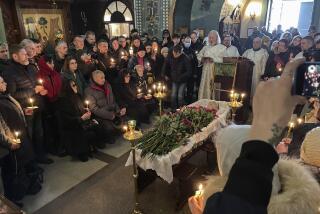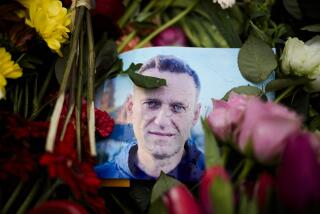COLUMN ONE : Burying the Soviet Past With Lenin : Anxious to end the legacy of communism, Russian authorities want to remove his body from its Red Square display. But grass-roots opposition is unexpectedly strong.
- Share via
MOSCOW — On the anniversary of the Bolshevik Revolution, 81-year-old Khadzhy-Batyr Badoyev decided it was time for a chat with Comrade Lenin.
So one day last month, Badoyev marched across a deserted Red Square. Down he went into the underground marble crypt where Vladimir Ilyich Ulyanov seems to float in his glass sarcophagus like Sleeping Beauty with a goatee.
The old soldier stood at Lenin’s feet and spoke aloud, shattering the reverent twilight.
“I was Red,” Badoyev told his fallen hero, ignoring the officious shushing of the neo-KGB honor guards. “And I remain Red!”
Two years ago, Badoyev and his countrymen watched their native land crumble beneath them. Then the new Russian government embarked on a terrifying economic bungee jump into the free-market void.
Russians are still waiting for the promised bounce back up. Small wonder that many people here are deeply nostalgic for the stable, old superpower Soviet Union and its founding father, V. I. Lenin.
But now, even the adoration of Lenin may soon be cut short.
The goose-stepping guards in front of the Lenin Mausoleum were banished after President Boris N. Yeltsin crushed a Parliament-led rebellion in October. It was the first sign that the Russian government would not for long tolerate Lenin’s tomb, an icon of the Soviet past, in its political epicenter, Red Square.
Next, Yeltsin ordered the closure of the Lenin Museum, a red-brick gingerbread Gothic across the square to the north. Distraught museum officials say they have no idea where to move the world’s largest collection of Lenin paraphernalia, including the revolutionary’s Rolls-Royce.
And the mayor of Moscow has formally proposed burying Lenin’s 123-year-old body next to his mother’s grave in a St. Petersburg cemetery. Red Square would be restored to its pre-revolutionary appearance--which would presumably mean demolishing the mausoleum itself. Even the glowing red stars would be plucked from their perch atop the Kremlin towers.
The Russian Orthodox Church has weighed in, favoring a “Christian” burial for Lenin, a fervent atheist.
All that remains is for Yeltsin to approve the burial of the founder of the Soviet Union--or have the new legislature, which is to be elected Sunday, do it for him.
But grass-roots opposition to tampering with Lenin is proving surprisingly strong, especially in the tradition-minded provinces.
Young people who have never seen Lenin want him to stay put until they have a chance to visit “the mummy.” His caretakers say his body is a precious scientific experiment that should not be disrupted. Preservationists say the post-Communist leadership should shun the Bolshevik practice of liquidating disliked pieces of history.
Thus the question of what to do with the First Corpse is becoming a litmus-test issue of today’s Russian politics.
“Lenin is a symbol of the attempt to build a just society,” said Grigory A. Pashkov of the Mnenie (Opinion) polling firm, who believes that burying Lenin now would be politically hazardous.
It took Soviet society 20 years after his death to come around to the view that dictator Josef Stalin was more criminal than national hero, and up to 10% of the population still reveres him, Pashkov said.
Changing the mind-set of a generation raised to regard Lenin as an international hero and socialist deity will take decades, he said.
Pashkov has been tracking public opinion about burying Lenin since the idea was first proposed to the now-defunct Congress of People’s Deputies in 1991. (Then-Soviet President Mikhail S. Gorbachev sagely tabled the touchy matter for future study.)
Muscovites favor burial by a nearly 3-1 margin, an October Mnenie poll showed. But even among denizens of the capital, opinions have fluctuated wildly.
In Russia as a whole, Pashkov’s polls find the population split nearly evenly over whether the revolutionary leader should be buried.
With public sentiment so volatile, the pollster believes it best to let the sleeping Lenin lie.
“If they forcibly accelerate the burial of Lenin, a significant portion of the population will be offended,” Pashkov said.
Alexei S. Abramov, who runs a private foundation that raises money for the mausoleum, points to a thick stack of letters that favor keeping the leader where he is.
Abramov formed the foundation because the elite Moscow biological institute charged with caring for the corpse has received “not a kopeck” from the government in 18 months.
“The mausoleum is a symbol of the Soviet Union, a great power that went from the wooden plow to the spaceship, that defeated Hitler’s army and that was the first to reach the cosmos,” Abramov said. “We must preserve Lenin.”
Abramov argues that a precious artifact could be lost to future generations amid the post-Communist rubble of toppled monuments, renamed streets and obsolete maps.
If Lenin’s body is preserved long enough for political passions to recede, he says, it could become a cultural asset--like the mummies of the Egyptian pharaohs, some of which are also on public display.
“No one in Egypt today is interested in Ramses II’s politics,” he said.
The Moscow Patriarchate, the Russian equivalent of the Vatican, declared in November that burial should not insult Lenin’s memory and that the issue “should not sow seeds of discord and antagonism in society.”
At the same time, it denounced as blasphemy the pickling and public presentation of the late leader as depriving him of the blessing of God.
What about the wishes of Lenin’s relatives, who were opposed to permanent embalming when he died in 1924?
Lenin’s only surviving relative is a niece, Olga Dmitriyevna Ulyanova, an elderly pensioner living in Moscow. In keeping with the spirit of Russia’s naked new capitalism, Ulyanova tried to extract $200 in return for an interview with a foreign newspaper.
But she told the Russian news agency Interfax that her uncle never left a will saying he wished to be buried alongside his mother, as advocates of that idea assert.
Moreover, she said, Lenin is already buried “in a Christian fashion” since his sarcophagus lies deep underground.
Noting that Yeltsin himself opposed burial in 1991, Ulyanova added: “One cannot ignore what he (Lenin) did. He was a prominent figure, a man of genius. . . . I’m against taking him out of the mausoleum.”
While the debate rages, the Russian press has been taking ghoulish delight in unearthing the morbid details of the preservation process that was long considered a Soviet state secret.
After Lenin died at age 53, authorities acceded to the throngs who demanded to see the body of their leader and had it embalmed so even more of the faithful could view it.
Citing unnamed sources, Komsomolskaya Pravda newspaper reported that in early restoration attempts in the 1930s, scientists replaced one-third of Lenin’s skin and all of his hair.
In 1941, fearful that it might fall into German hands, authorities evacuated the body and its medical entourage for the duration of the war to Tyumen in western Siberia in an operation so secret that even Tyumen’s “czar and god”--the local Communist Party first secretary--was kept in the dark.
Out of its carefully controlled environment--60.8 degrees Fahrenheit, humidity 17%--the corpse began to deteriorate, and part of the left hand had to be amputated and replaced with a skillful replica, the newspaper said.
But two men who cared for the corpse, in separate interviews, scoffed at reports that any part of Lenin is wax.
“The body is very well preserved. It’s his nose, it’s his fingers,” said Sergei S. Debov, who heads the Laboratory of Biological Structures.
Lenin’s hair looks less than natty only because his wife, Nadezhda K. Krupskaya, gave him a bad haircut shortly before he died, Debov said.
“The question of whether to bury Lenin is purely political,” Debov said.
Still, he said, “he’s been preserved 70 years, and that is unprecedented. It would be a shame to end the experiment.”
Ilya B. Zbarsky, whose father first embalmed Lenin, cared for the corpse from 1934 to 1952, when he and his father were fired from the mausoleum in a Stalin purge.
Zbarsky believes that the corpse should be buried, but he would spare the mausoleum. He remembers as a child watching Bolshevik bulldozers demolish the Cathedral of Christ the Savior, one of the most beautiful and beloved churches in Moscow. “Some monuments to the history of the country must remain,” he said.
For now, the Lenin Mausoleum hews to its rituals. Twice a week, it is closed to visitors and a medical team arrives to swab Lenin’s hands and face with preserving creams. Every 18 months, the corpse is immersed in embalming fluid for several weeks, “imperfections” are remedied and the aging hero is fitted with a new suit, Debov said.
If properly cared for, the body could last “indefinitely”--at least another 50 to 100 years, he said.
The artistry of the embalming is such that an American funeral home once told Debov that in the West he could probably charge $3 million for a similar preservation program. Debov, who is short of money for his institute’s main work, pharmacologic research, says he would welcome such an offer.
Meanwhile, Lenin endures.
The old revolutionary himself would not have hesitated to oust a rival’s remains from their place of honor.
But before Lenin’s fate is decided, a Kremlin spokesman said, Russia should have a funeral for his victims, the Romanov family, whose remains were discovered in Ekaterinburg in 1991.
Before tangling with Lenin, Russia will bury her czar.
More to Read
Sign up for Essential California
The most important California stories and recommendations in your inbox every morning.
You may occasionally receive promotional content from the Los Angeles Times.













